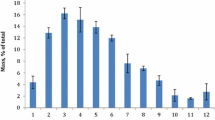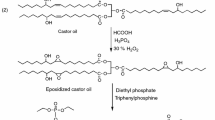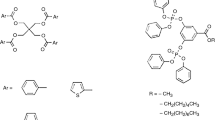Abstract
Castor oil is a non-edible plant oil produced in a large quantity annually. It is a triglyceride of primarily (approximately 90%) ricinoleic acid. The acid residues contain both a hydroxyl group and a double bond which permit ready functionalization. The hydroxyl group may be converted to phosphorus esters of varied structure while the unsaturation readily undergoes addition of bromine. Derivatives of castor oil containing phosphorus, bromine, or phosphorus and bromine have been prepared and fully characterized using spectroscopic and thermal methods. The thermal stability and mode of degradation for these compounds have been assessed using thermogravimetry and infrared spectroscopy. The primary mode of degradation for the phosphorus esters is elimination of the corresponding phosphorus acid (phosphates more readily than phosphonates). Brominated castor oil undergoes thermally induced dehydrobromination at relatively modest temperatures and this promotes dehydration (at temperatures well below that required for dehydration of unmodified castor oil). Brominated phosphorus esters of castor oil undergo degradation initiated by dehydrobromination.

















Similar content being viewed by others
References
Chen GQ, Patel MK. Plastics derived from biological sources: present and future: a technical and environmental review. Chem Rev. 2012;112:2082–99.
Tschan MJL, Brule E, Hapquette P, Thomas CM. Synthesis of biodegradable polymers from renewable resources. Polym Chem. 2012;3:836–51.
Mulhaupt R. Green polymer chemistry and biobased plastics: dreams and reality. Macromol Chem Phys. 2013;214:159–74.
Williams CK, Hillmyer MC. Polymers from renewable resources: a perspective for a special issue of polymer reviews. Polym. Rev. 2008;48:1–10.
Malinconico M, Cerruti P, Santagata G, Immirzi B. Natural polymers and additives in commodity and specialty application: a challenge for the chemistry of the future. Macromol Symp. 2014;337:124–33.
Datta J, Kasprzyk P. Thermoplastic polyurethanes derived from petrochemical or renewable resources: a comprehensive review. Polym Eng Sci. 2018;58:E14–35.
Doppalapudi S, Jain A, Khan W, Domb AJ. Biodegradable polymers—an overview. Polym Adv Technol. 2011;22:139–50.
Rowe MD, Eyiler E, Walters KB. Biobased plasticizers and thermoset polyesters: a green polymer chemistry approach. J Appl Polym Sci. 2016;133:43917.
Howell BA, Carter KE, Dangalle H. Flame retardants based on tartaric acid: a renewable by-product of the wine industry. In: Payne GF, Smith PB, editors. Renewable and sustainable polymers (ACS symposium series 1063), chapter 9. Washington: American Chemical Society; 2011. p. 133–52.
Costes L, Laoutid F, Brohez S, Dubois P. Bio-based flame retardants: when nature meets five protection. Mater Sci Eng R. 2017;117:1–25.
Liu Y, Zhang Y. Design, synthesis, and application of novel flame retardants derived from biomass. Bioresources. 2012;7:4914–25.
Daniel YG, Howell BA. Flame retardant properties of isosorbide bis-phosphorus esters. Polym Degrad Stab. 2017;140:25–31.
Feng X, East AJ, Hammond WB, Zhang Y, Jaffe M. Overview of advances in sugar-based polymers. Polym Adv Technol. 2011;22:139–52.
Montero de Espinosa L, Meier MAR. Plant oils: the perfect renewable resource of polymer science. Eur Polym J. 2011;47:837–52.
Mosiewicki MA, Aranguren MI. Recent developments in plant oil based functional materials. Polym Int. 2016;65:28–38.
Ogunniyi DS. Castor oil: a vital industrial raw material. Bioresour Technol. 2006;97:1086–91.
Kumar A, Sharma S. Potential non-edible oil resources as biodiesel feedstock: an Indian perspective. Renew Sustain Energy Rev. 2011;15:1791–800.
Jia PY, Bo C-Y, Zhang L-Q, Hu L-H, Zhang M, Zhou Y-H. Synthesis of castor oil based plasticizers containing flame retarded groups and their application in poly(vinyl chloride) as a secondary plasticizer. J. Ind. Eng. Chem. 2015;28:217–24.
Trevino AS, Trumbo DJ. Acetoacetylated castor oil in coatings applications. Prog Org Coat. 2002;44:49–54.
Gurunathan T, Arukula R, Chung JS, Rao CRK. Development of environmentally friendly castor oil-based water polyurethane dispersions with polyaniline. Polym Adv Technol. 2016;27:1535–40.
Kunduru KR, Basu A, Zada MH, Domb AJ. Castor oil-based biodegradable polyesters. Biomacromolecules. 2015;16:2572–87.
Sathiskumar PS, Mardras G. Synthesis, characterization, degradation of biodegradable castor oil based polyesters. Polym Degrad Stab. 2011;96:1695–704.
Paluvai NR, Mohanty S, Nayak SK. Cure kinetics of exfoliate biobased epox/clay nanocomposites developed from acrylated epoxidized castor oil and diglycidyl ether bisphenol a networks. High Perform Polym. 2015;27:918–29.
Das G, Trivedl RK, Vasishtha AK. Heptaldehyde and undecylenic acid from castor oil. JAOCS. 1989;66:938–41.
Vishwanadham B, Sripathi Rao H, Sadasivudu D, Khan AA. Pyrolysis of castor oil methyl esters of 10-undecenoic acid and heptaldehyde. Indian J Chem Technol. 1995;2:119–28.
Daniel YG, Howell BA. Synthesis and characterization of isosorbide bis-phosphorus esters. Heteroat Chem. 2017;28:e21369.
Jia P, Feng G, Bo C, Hu L, Yang X, Zhang L, Zhang M, Zhou Y. A composition of phosphaphenanthrene groups-containing castor-oil-based phosphate plasticizer for PVC: synthesis, characterization and property. J Ind Eng Chem. 2018;60:192–205.
Jia P, Hu L, Feng G, Bo C, Zhou J, Zhang M, Zhou Y. Design and synthesis of a castor oil-based plasticizer containing THEIC and diethyl phosphate groups for the preparation of flame-retardant PVC materials. RSC Adv. 2017;7:897–903.
Jia P, Hu L, Zhang M, Zhou Y. TG-FTIR and TG-MS analysis applied to study the flame retardancy of PVC-castor-oil-based Chlorinated Phosphate Ester Blends. J Therm Anal Calorim. 2016;124:1331–9.
Jia P, Zhang M, Hu L, Bo C, Zhou Y. Synthesis, application and flame-retardant mechanism of a novel phosphorus-containing plasticizer based on castor oil for poly(vinyl chloride). J Therm Anal Calorim. 2015;120:1731–40.
Jia P, Zhang M, Liu C, Hu L, Feng G, Bo C, Zhou Y. Effect of chlorinated phosphate ester based on castor oil on thermal degradation of poly(vinyl chloride) blends and its flame retardant mechanism as secondary plasticizer. RSC Adv. 2015;5:41169–78.
Jia P, Hu L, Zhang M, Feng G, Zhou Y. Phosphorus containing castor oil based derivatives: potential non-migratory flame retardant plasticizer. Eur Polym J. 2017;87:209–20.
Acknowledgements
Diphenylchlorophosphate was generously provided by ICL-IP America, Inc.
Author information
Authors and Affiliations
Corresponding author
Additional information
Publisher's Note
Springer Nature remains neutral with regard to jurisdictional claims in published maps and institutional affiliations.
Rights and permissions
About this article
Cite this article
Howell, B.A., Ostrander, E.A. Thermal degradation of flame-retardant compounds derived from castor oil. J Therm Anal Calorim 138, 3961–3975 (2019). https://doi.org/10.1007/s10973-019-08355-w
Received:
Accepted:
Published:
Issue Date:
DOI: https://doi.org/10.1007/s10973-019-08355-w




